Revelation - Lesson 3
Thrones, Seals, Trumpets
Revelation 4-11
Background Information for the Teachers
Objectives:
- The student can identify the main symbols in Revelation and explain its basic story.
Preparation:
- Post any pictures you plan to have for students to look at. Two color pictures are provided on separate documents that are good to post for this lesson. One shows the scroll and what happens as each is opened. The other shows what happens as each trumpet is blown. These could be posted or copied and given to students.
- If you choose to do it, have ready your visuals-overhead projector and transparencies, PowerPoint or chalkboard.
- Have enough of the student worksheets for all the students to have one.
- Have enough copies of the Story of Revelation Worksheet from a separate document for students to have so they may begin filling it in. This will be used for several lessons so you need to plan a way students can keep their copies. They will need them to study for the quizzes but you also need to be sure they have them back to use for the next class period.
- Have copies of Test 2 ready for students as they enter class. It is provided at the end of this lesson.
- Have pens/pencils ready for use.
- All students should have access to a Bible.
- You may wish to consult some of the recommended books as additional background for this lesson.
Theme:
The message Christ wants to send to His churches is put in the form of a drama using symbols for the major players. In chapters 4 through 11, He shows the stage, introduces the major theme of the message, and begins to unfold the story in what is seen as Act I.
Lesson Plan for Conducting Class
Introduction: (about 10 minutes)
- If you want to save some time, give the test to students as they enter or a few minutes before time for class to start. Ask them to complete it and you will give the answers later. If you prefer, you can wait until class starts and make the test time part of the introduction to class.
- Call the roll, welcome visitors, and make any necessary announcements.
- Songs (as desired)
- Worthy is the Lamb
- Worthy Art Thou
- All Hail the Power of Jesus Name
- Prayer praising the name and power of Jesus as our redeemer and helper.
- Give answers to Quiz No. 2 as a review of last week's lesson. No. 1-John; Patmos. No. 2-lampstands No. 3-seven; (any of the seven churches is correct). No. 4-Ask students to share a lesson they have learned. Look especially for those we studied last week-Christ knows us well, Christ wants us to stand for truth, even if we are poor we can be rich, we should be growing in service, Christ wants us to live by His moral standards, Christ wants us to have great hope
Learning Experiences: (30 minutes)
- Hand out the Story of Revelation Worksheets. Emphasize to the students the importance of this outline. It is the summation of the message of the Book of Revelation and thus is what you want them to recall about the book when class is over. It will be the basis of five lessons and they will need to bring it to class each time so they will have it for the next lesson. Have the students fill in the Worksheet Introduction: John on Patmos, Radiant man appears, Christ dictates letters to the 7 churches.
- In Chapter 4 the curtain opens on the play we will be observing. First we look around the stage. Visual:
 Note in the drawing each of the things mentioned below. Q: Who sits on the throne in the center of heaven? 4:2-3. (God, shown here as one with the appearance of precious jewels.) Q: What was in a circle around this central throne? 4:4. (24 more thrones?) Q: Who sat here and what did they do? 4:4, 10 (24 elders who praise God. Who else is pictured as part of this stage setting? 4:6b-8; 5:11, 13. (Four living creatures, a huge number of angels and every creature in heaven and on earth.) Now, fill in Act I, A 1 on the worksheet. So the center of the stage for the drama presented in Revelation is God's Throne Room in heaven. Also on the stage are 24 elders, 4 living creatures, myriads of angels, and every living creature. Q: What message do you get from the picture thus far? (That God is powerful, reigns in majesty, and is in control.) What a great message this is for the persecuted Christians who first received the book!
Note in the drawing each of the things mentioned below. Q: Who sits on the throne in the center of heaven? 4:2-3. (God, shown here as one with the appearance of precious jewels.) Q: What was in a circle around this central throne? 4:4. (24 more thrones?) Q: Who sat here and what did they do? 4:4, 10 (24 elders who praise God. Who else is pictured as part of this stage setting? 4:6b-8; 5:11, 13. (Four living creatures, a huge number of angels and every creature in heaven and on earth.) Now, fill in Act I, A 1 on the worksheet. So the center of the stage for the drama presented in Revelation is God's Throne Room in heaven. Also on the stage are 24 elders, 4 living creatures, myriads of angels, and every living creature. Q: What message do you get from the picture thus far? (That God is powerful, reigns in majesty, and is in control.) What a great message this is for the persecuted Christians who first received the book! - In Chapter 5, the action of the play begins. Q: In His lap, God has what? 5:1 (A scroll with seven seals which guard it from being opened.) At first, no one is found worthy to open the scroll. Visual:
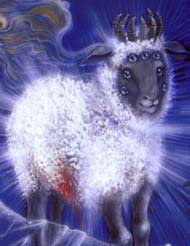 Q: Who does John see that will be able to open the seals on the scroll? (a lamb with seven eyes and seven horns.) No. A 2. The triumphant, powerful lamb looks as if he has been slain and is alive again. He is called the lion of the tribe of Judah and the root of David. Q: Who would fit this description? (only Jesus Christ) Q: What important time marker does this give us for the start of the story of Revelation? (Christ has died, been raised and has returned to heaven. So the story begins not long after Christ's ascension.) In the story, each time the lamb opens a seal, another part of the story is told. Thus Christ will reveal the message of Act I, the contents of the first scroll.
Q: Who does John see that will be able to open the seals on the scroll? (a lamb with seven eyes and seven horns.) No. A 2. The triumphant, powerful lamb looks as if he has been slain and is alive again. He is called the lion of the tribe of Judah and the root of David. Q: Who would fit this description? (only Jesus Christ) Q: What important time marker does this give us for the start of the story of Revelation? (Christ has died, been raised and has returned to heaven. So the story begins not long after Christ's ascension.) In the story, each time the lamb opens a seal, another part of the story is told. Thus Christ will reveal the message of Act I, the contents of the first scroll. - In Chapter 6, the Lamb begins to open the scroll. As each seal is opened, some action then takes place. Thus, Christ will reveal the message of Act 1. Q: The opening of the first four seals, results in the same type of action. What is it? (a rider comes across the stage on a horse) Visual:
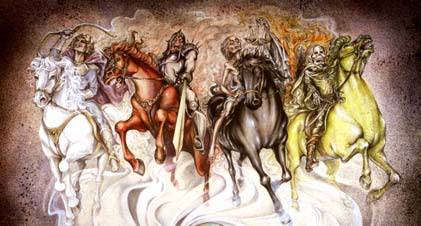 The riders are given something. Q: The first rider is on a white horse and has a bow. Q: What is he given? 6:2. (a crown and is told to go forth and conquer.) The second rider is on a red horse. Q: What is he given? (a sword and power to take peace from the earth.) The third rider is on a black horse. He already has a balance (scale) in his hand and a voice gives him the price of the grain he measures and, since it is a high price for food, this rider suggests scarcity of food and economic distress. The fourth rider is on a pale horse and he is named Death. Q: What power is he given? (The power over one-fourth of the earth to kill by sword, famine, and plague.) Q: Who gives these horsemen their power and orders? (Since they are riding across the stage where God sits on the throne, they receive their power from God. Thus, they are God's agents. Satan has not even been introduced into the story yet.) Q: Who do these horsemen affect? (Nations of the world. They conquer, bring war, economic distress, and other hardships.) No. A 3. Thus, the parade of these four horsemen is a parade of God's power over nations of the earth. As Paul said in Acts 17:26, God sets the boundaries of where nations live. So the message of Revelation begins with establishing who is in control of the affairs of nations. While humans have the power to make decisions, God weaves those decisions into the tapestry of His will.
The riders are given something. Q: The first rider is on a white horse and has a bow. Q: What is he given? 6:2. (a crown and is told to go forth and conquer.) The second rider is on a red horse. Q: What is he given? (a sword and power to take peace from the earth.) The third rider is on a black horse. He already has a balance (scale) in his hand and a voice gives him the price of the grain he measures and, since it is a high price for food, this rider suggests scarcity of food and economic distress. The fourth rider is on a pale horse and he is named Death. Q: What power is he given? (The power over one-fourth of the earth to kill by sword, famine, and plague.) Q: Who gives these horsemen their power and orders? (Since they are riding across the stage where God sits on the throne, they receive their power from God. Thus, they are God's agents. Satan has not even been introduced into the story yet.) Q: Who do these horsemen affect? (Nations of the world. They conquer, bring war, economic distress, and other hardships.) No. A 3. Thus, the parade of these four horsemen is a parade of God's power over nations of the earth. As Paul said in Acts 17:26, God sets the boundaries of where nations live. So the message of Revelation begins with establishing who is in control of the affairs of nations. While humans have the power to make decisions, God weaves those decisions into the tapestry of His will. - Now we move to 6:9-11. These are the most important verses in the entire book for understanding the theme of Revelation. No. A 4. As the fifth seal is opened, John sees souls under the altar. Visual:
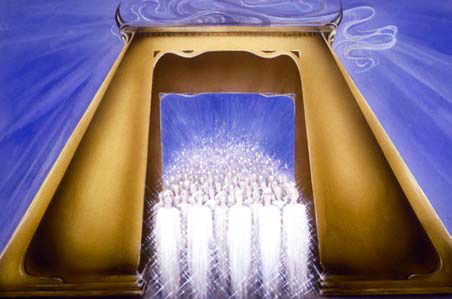 Q: Who are these souls? (Those who were killed because of the word of God and their testimony.) They are early martyrs of the cause of Christ. Q: What question do these martyrs ask God? (How long until you judge the inhabitants of the earth and avenge our blood?) Thus, they call on God to judge those who have persecuted Christians and thus to avenge the blood they have shed. This, no doubt, was the question Christians of this time were asking-"Since God is really in control, why does the one persecuting us seem to be getting by with it? How long before God will right the scales of justice? The Book of Revelation is written to answer this question for those Christians in the seven churches, and elsewhere, who were about to undergo the terrible persecution of those early centuries. Q: What is God's answer to their question? (He gives each a white robe and tells them to wait a little longer because more Christians are to be killed before God brings this to an end.) Q: Looking back, now, on that persecution of Christians then, what do we know was the result of it? (It spread Christianity and drew people to it because of the commitment and faithfulness of those Christians who were willing to endure it.) So in 6:9-11, we learn that the church has begun and that some have already been persecuted. The question on the mind of Christians is how long this persecution will continue and whether God will punish the persecutors. God says the persecution will continue for a while before He ends it, but He will end it and punish the persecutor. Hold this basic message in your mind as we continue our study of the book. A 4. Early martyrs ask "How long" until you judge and avenge our blood.
Q: Who are these souls? (Those who were killed because of the word of God and their testimony.) They are early martyrs of the cause of Christ. Q: What question do these martyrs ask God? (How long until you judge the inhabitants of the earth and avenge our blood?) Thus, they call on God to judge those who have persecuted Christians and thus to avenge the blood they have shed. This, no doubt, was the question Christians of this time were asking-"Since God is really in control, why does the one persecuting us seem to be getting by with it? How long before God will right the scales of justice? The Book of Revelation is written to answer this question for those Christians in the seven churches, and elsewhere, who were about to undergo the terrible persecution of those early centuries. Q: What is God's answer to their question? (He gives each a white robe and tells them to wait a little longer because more Christians are to be killed before God brings this to an end.) Q: Looking back, now, on that persecution of Christians then, what do we know was the result of it? (It spread Christianity and drew people to it because of the commitment and faithfulness of those Christians who were willing to endure it.) So in 6:9-11, we learn that the church has begun and that some have already been persecuted. The question on the mind of Christians is how long this persecution will continue and whether God will punish the persecutors. God says the persecution will continue for a while before He ends it, but He will end it and punish the persecutor. Hold this basic message in your mind as we continue our study of the book. A 4. Early martyrs ask "How long" until you judge and avenge our blood. - In chapter 6:12, the sixth seal is opened and many images are presented of what will happen on the earth such as a great earthquake, the sun being darkened, the moon turning to the color of blood, the stars falling, and people running to find caves to hide in. Q: Does this sound like the end of the world? (Maybe to some. But will people be able to run for caves when the end of the world comes?) Actually these are all figures of speech from different passages in the Old Testament that all were about the same subject when originally used. Have someone read Isaiah 13:10. Then have them read, as an example of these passages, Isaiah 13:1. Q: So the fall of the nation of Babylon was compared to what? (The sun, moon, and stars being darkened.) This is just a figure of speech for saying that the day Babylon falls will be a very significant day. A 5. So the use of all of these "pictures" from the Old Testament about the fall of nations is a way for John to say that his message, like the prophets of old, will be about the fall of a nation.
- Now comes an interlude between the sixth and seventh seals starting in Chapter 7. God tells those to whom He has given power to affect the earth not to start yet. Q: What does God want to do first? 7:3 (Put a seal on the forehead of His servants.) Q: Where are those God wants to mark? (on the earth-do not hurt the earth.) Q: How many of these are there? (144,000-a symbolic number suggesting completeness.) So God will mark all those who are His, He will miss none of them. These are said to be from the 12 tribes of Israel. Q: Who are the Israel of God by the time Revelation is written? Someone read Galatians 6:16. Speaking to the church, Paul says "We are the Israel of God." (See also Philippians 3:3.) So John uses the figure of 144,000 Jews to represent the totality of the church about to be persecuted. A 6. God wants them to know that He will protect them and they are His, just as much as if He had written His name on them. (Teacher: Put your right hand above the left and say-this is what it says, and this is what it means.)Q: In a western movie, how do we identify the good guys and the bad guys? (By the color of their hats.) So in this play, the people of God get a mark to identify them and, as we shall see later, those who follow Satan also get a mark. God wants those Christians, about to undergo terrible persecution to know that He has "branded" them as His and no matter what happens, He will care for them..
- Then, John sees a great multitude in heaven serving God and enjoying great happiness. Q: What are they wearing? So who are they? (white robes and they are those in 6:9 who were the early martyrs and asked when God would avenge their blood.)
- Visual:
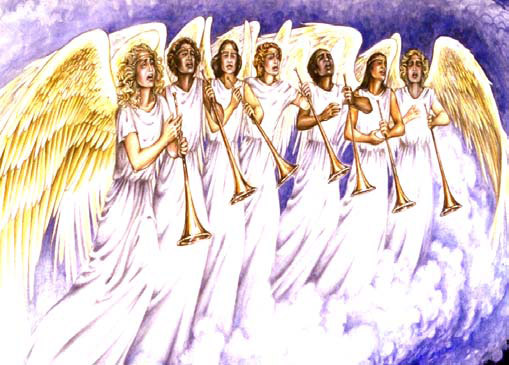 The seventh seal is now opened, Chapter 8, and seven angels are given seven trumpets to blow. Remember the seven trumpets are introduced by the seventh seal so the time of the seals is not over until the seventh trumpet is sounded. This is shown by the drawing on your sheet. As each trumpet sounds, something happens.As the first four trumpets sound, 1/3 of the land burns up, 1/3 of the sea turns to blood, 1/3 of the rivers become bitter, and 1/3 of the sun, moon, and stars go dark. Q: In general, what is affected by these first four trumpets? (All of nature-earth, seas, rivers, sky.) Q: To what extent are they affected? (1/3 suggests partial destruction, not complete). Q: In the Old Testament times, why were trumpets often blown? (to warn) For a moment let's skip past the sixth trumpet to see what is said there that might help us. Someone read 9:20-21. Q: Those left after the plagues did not do what? (repent) So the trumpets were designed to encourage someone to repent. They sounded warnings. Q: Did the ones whom the trumpets were to warn change their ways? (no) Q: What did they keep on doing? (worshipping false gods, killing, stealing, and immorality) In other words, those being warned, did not change their ways; they continued to persecute the people of God. The events of the trumpets are to warn the persecutor who had killed the souls under the altar, but he does not stop his false worship and persecution.B 1. Thus, the first four trumpets suggest that God will use partial destruction through natural disasters symbolized by the partial destruction on land, sea, rivers, and sky. God will warn by floods, earthquakes, volcanic eruptions, fires, winds. And these disasters will provide partial destruction and thus a warning to the persecutor. As an example, it was in 79 AD, just about this time, that Vesuvius erupted and covered Pompeii. This may be one of the disasters here suggested.
The seventh seal is now opened, Chapter 8, and seven angels are given seven trumpets to blow. Remember the seven trumpets are introduced by the seventh seal so the time of the seals is not over until the seventh trumpet is sounded. This is shown by the drawing on your sheet. As each trumpet sounds, something happens.As the first four trumpets sound, 1/3 of the land burns up, 1/3 of the sea turns to blood, 1/3 of the rivers become bitter, and 1/3 of the sun, moon, and stars go dark. Q: In general, what is affected by these first four trumpets? (All of nature-earth, seas, rivers, sky.) Q: To what extent are they affected? (1/3 suggests partial destruction, not complete). Q: In the Old Testament times, why were trumpets often blown? (to warn) For a moment let's skip past the sixth trumpet to see what is said there that might help us. Someone read 9:20-21. Q: Those left after the plagues did not do what? (repent) So the trumpets were designed to encourage someone to repent. They sounded warnings. Q: Did the ones whom the trumpets were to warn change their ways? (no) Q: What did they keep on doing? (worshipping false gods, killing, stealing, and immorality) In other words, those being warned, did not change their ways; they continued to persecute the people of God. The events of the trumpets are to warn the persecutor who had killed the souls under the altar, but he does not stop his false worship and persecution.B 1. Thus, the first four trumpets suggest that God will use partial destruction through natural disasters symbolized by the partial destruction on land, sea, rivers, and sky. God will warn by floods, earthquakes, volcanic eruptions, fires, winds. And these disasters will provide partial destruction and thus a warning to the persecutor. As an example, it was in 79 AD, just about this time, that Vesuvius erupted and covered Pompeii. This may be one of the disasters here suggested. - The fifth trumpet is blown (9:1-11) and locusts come out of the abyss-the residence of evil throughout the Book of Revelation. Q: The locusts hurt only whom? 9:4. (Those who do not have the seal of God.) Thus, the locusts come from the seat of evil and hurt only evil people. This symbolizes the harm that evil brings to those who do it. One of God's warnings will be to let evil have its harmful effect on the evil persecutor. B 2. Thus, God will bring partial destruction to the Roman persecutor come from the effects of their immorality and corruption.
- The sixth trumpet is blown (9:13-19). With this John sees a huge army crossing the Euphrates River to destroy. Since the Euphrates River was the eastern boundary of the Roman Empire, to suggest a huge army crossing that river to attack is to suggest that soldiers of those who opposed Rome were allowed to make incursions into Roman territory. B 3. So God will bring partial destruction from outside attacks.
- Now we have the warnings of the six trumpets before us-warnings against the persecutor from natural disasters, from its own evil and corruption, and from outside attacks. From history we know that the three primary causes for the eventual fall of the Roman Empire were natural disasters, internal corruption, and attacks from outside by the Huns, Goths, Vandals and others. So God will begin these processes as a warning to see if Rome will stop its persecution. The Romans, however, the great persecutor of the early church, will not change. This is suggested in the 9:20-21 we have seen earlier.
- Now comes Chapter 10. Visual:
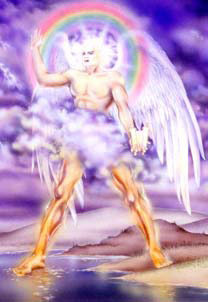 A large angel comes to stand on the sea and on the land. He has a second scroll in his hand and tells John to eat the scroll and prophesy again. Thus, John is given the contents of a second scroll, or Act II, as the first one is about to come to an end. Then in Chapter 11, John is told that the "temple" or church will be under attack for 42 months and that the witnesses will be under attack for 1260 days, the same length of time. This period of time in Revelation always suggests a time of persecution led by the beast (the Roman Empire). The two witnesses, representing all persecuted Christians, are killed and lie in the streets of the beast's "great city" for three days while the persecutors think they have won. But then God brings them back to life and takes them to heaven, suggesting they will be vindicated and approved by God and their cause will survive. C 2. The persecutor, then, was warned through the partial destruction indicated by the trumpets but,instead of repenting and stopping the persecution, he makes it worse during a time symbolized by 1260 days or 42 months. C 3. Christians, however, symbolized by the two witnesses, remain faithful and keep giving their testimony.
A large angel comes to stand on the sea and on the land. He has a second scroll in his hand and tells John to eat the scroll and prophesy again. Thus, John is given the contents of a second scroll, or Act II, as the first one is about to come to an end. Then in Chapter 11, John is told that the "temple" or church will be under attack for 42 months and that the witnesses will be under attack for 1260 days, the same length of time. This period of time in Revelation always suggests a time of persecution led by the beast (the Roman Empire). The two witnesses, representing all persecuted Christians, are killed and lie in the streets of the beast's "great city" for three days while the persecutors think they have won. But then God brings them back to life and takes them to heaven, suggesting they will be vindicated and approved by God and their cause will survive. C 2. The persecutor, then, was warned through the partial destruction indicated by the trumpets but,instead of repenting and stopping the persecution, he makes it worse during a time symbolized by 1260 days or 42 months. C 3. Christians, however, symbolized by the two witnesses, remain faithful and keep giving their testimony. - Then the seventh trumpet is sounded (11:15). Q: What is the mood in heaven when this trumpet is blown? (great joy and celebration) Q: Why? 11:17-18. (Because God, who has been holding back the destruction of the persecutor (6:11) will now take His power and use it to destroy the one who has been doing the destroying. D. Thus, the announcement has been made that God is going to bring the persecutor to defeat. The story has not yet reached that point, but there is rejoicing in heaven because that announcement has been made.
- And so ends the information made available by opening the seven seals, including the seven trumpets, and so ends Act I with great anticipation in heaven because God is now ready to make His move.
Application: (4 minutes)
- Q: What do we learn about God from Revelation 4-11.
- Q: What do we learn about God's enemies from Revelation 4-11.
- Q: What should we do in response to who God is?
Assignment: (1 minute)
- Review at your notes on the exercise sheet and complete them where necessary.
- Prepare for the quiz over Rev. 4-11 at the next class period.
- Read Revelation 12-15 for next class period.
Evaluation:
- Written quiz at the next class period. (Download test over Lesson 2 below)
- Completion of worksheet to study. This will eventually be collected for review by the teacher.
Download Worksheets
Back to Revelation

This work is licensed under a Creative Commons Attribution-NonCommercial-NoDerivatives 4.0 International License.